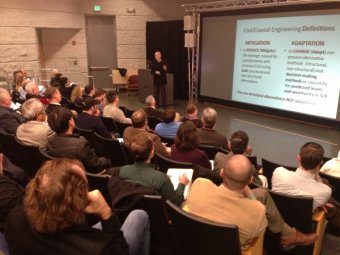There's no shortage of studies on sea level rise in Hampton Roads. The binders would overwhelm a filing cabinet.
They all agree the water is coming. After that, it gets a little murky.
How high will it rise? How fast? Are historic trends accelerating? Is that in meters or feet? Does that include sinking land, subsidence? What if the Greenland ice sheet melts? What if the Gulf Stream slows down?
While scientists embrace uncertainty, it's enough to make city planners and engineers a little crazy, or at least clamor for guidance.
"We need in Virginia to determine what is the acceptable rise we're going to plan around," said Clay Bernick, environment and sustainability coordinator for Virginia Beach. "We can't say Norfolk is going to plan for this, and Virginia Beach is going to plan for that. That would drive us nuts."
On that, most people agree. Despite the wealth of information, Virginia has no official strategy for sea level rise. Data has yet to yield policy.
Meanwhile, major projects in low-lying Hampton Roads - bridges, tunnels, roads - move forward with each agency trying to work out the complexities of sea level rise. On some, such as Norfolk's light-rail line, sea level rise wasn't factored in, said Ron Williams Jr., a Norfolk assistant city manager.
"We're grabbing whatever's out there, and it's widely varied," said Ted Henifin, general manager of the Hampton Roads Sanitation District, which handles sewage treatment. "If there was a definite number everybody could agree on, that would make our long-term planning easier. We wouldn't be on our own."
State leadership could be on the way - from a seemingly unlikely source. A state emergency management panel created after the Sept. 11 terrorist attacks last year formed a sub-panel to tackle coastal flooding problems.
The risk of sea level rise, the data show, could be as significant as a terrorist attack or a hurricane, said Jim Redick, Norfolk's director of emergency preparedness and response and co-chairman of the Recurring Coastal Flooding Subpanel of the Secure Commonwealth Panel.
He said the group will develop recommendations in the next six months that will include putting a state agency in charge of sea level rise and figuring out what data to use for local planning. Coordination at the state level would help attract federal money for projects, he said.
"The way it is right now, we have no overall strategy to make sure we're making the best use of funds and to prioritize projects," he said. "If we don't have a unified effort, we're not going to be very competitive for funds."
The recommendations will likely be turned over to another committee recently authorized by the General Assembly, he said. That committee has been charged with developing a "comprehensive and coordinated effort to address recurrent flooding." The group is tasked with submitting a report to the General Assembly by Nov. 1, 2015.
"Basically, what we're trying to do is coordinate the different efforts going on between localities, the military and other agencies within the commonwealth," said Del. Chris Stolle, a sponsor of the bill to create the committee.
A spokeswoman for Gov. Terry McAuliffe said the governor "takes very seriously the threat that sea level rise poses to coastal Virginia - particularly the Hampton Roads region."
The slow evolution of action in Virginia has created a kind of study fatigue among people itching to do something about sea level rise.
"Virginia needs to do more than study the problem with another committee," Old Dominion University professor of civil and environmental engineering David Basco said at a recent speech. "I'm getting old. I'm getting tired of studies, studies, studies. Let's get out and do something."
Basco said some of his students, as part of a class, will be looking at the feasibility of a sea wall across the Elizabeth River between the Norfolk Naval Station and Craney Island.
Scientists say it shouldn't be too hard for Virginia to rally around a sea level rise prediction.
"There are a variety of folks running around with at variety of forecasts," said Carl Hershner, director of the Center for Coastal Resources Management at the Virginia Institute of Marine Science. "No one is better than the other, and we all know what each other's stuff is. Really, what we need to agree on going forward is what set of scenarios will we refer to."
The key, he said, will be constantly refining the numbers as conditions change and science improves.
Hershner was part of the team that wrote a 141-page report on flooding delivered to the General Assembly last year. It may contain the most frequently used predictions for sea level rise in Virginia. A graph depicts four scenarios that range from 1-1/2 to 7-1/2 feet by 2100.
Hershner said he usually refers people to one he calls the "business-as-usual" scenario for a shorter time frame.
"Look, if you're going to plan, you ought to be thinking about 2-1/2 feet of sea level rise sometime in the next 40 to 60 years," he said.
The tide gauge off Norfolk's Sewells Point has shown about a 2-inch increase per decade since 1927, commonly extrapolated to almost 1-1/2 feet per century. Most scientists believe that rate is accelerating.
Last year's state study concluded that "localities are not adequately empowered to address the issues through policy and management actions" and "do not have the financial resources" to deal with flooding. It said the state should absorb "flood and sea level rise management into state purviews."
While the state effort takes shape, cities are forging ahead.
Virginia Beach is working on a plan for chronic flooding in three neighborhoods between the Lynnhaven River and the Chesapeake Bay.
Norfolk hired a consultant who identified what city leaders call their "$1 billion dollar problem" with sea level rise.
Officials are in discussions with the U.S. Army Corps of Engineers on flood wall projects including the Hague and Pretty Lake area. The city recently elevated one side of Brambleton Avenue to curtail flooding.
The corps uses a formula, based on federal studies, to predict and plan for sea level rise. It currently shows a rise in Hampton Roads of between 1 and 3 feet over the next 50 years, said Michelle Hamor, chief of the agency's flood plain management services section.
In the end, some leaders envision standardized planning for sea level will become part of any project, whether it's a road or a housing development.
"We still have a ways to go," said Joe Bouchard, a former state delegate and commanding officer of the Norfolk Naval Station, who works on sea level rise issues. "But at this point, I'm optimistic. We're moving in the right direction. Our local governments get it."
Williams of Norfolk said it comes down to, "How will the city evolve when we know this is happening? How do we live with the water?"
Originally printed http://hamptonroads.com/2014/03/cities-hope-state-guidance-sea-rise.




